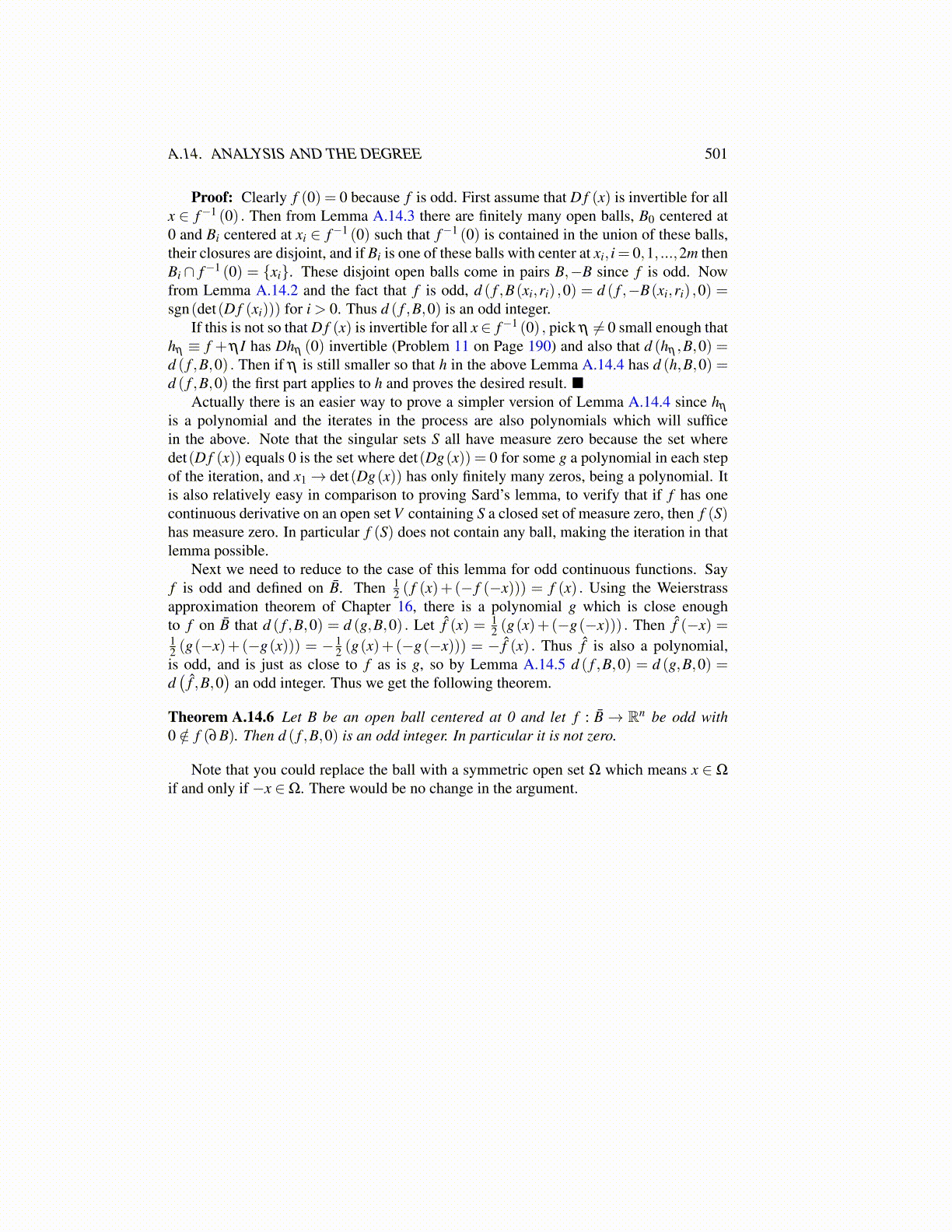
A.14. ANALYSIS AND THE DEGREE 501
Proof: Clearly f (0) = 0 because f is odd. First assume that D f (x) is invertible for allx ∈ f−1 (0) . Then from Lemma A.14.3 there are finitely many open balls, B0 centered at0 and Bi centered at xi ∈ f−1 (0) such that f−1 (0) is contained in the union of these balls,their closures are disjoint, and if Bi is one of these balls with center at xi, i= 0,1, ...,2m thenBi ∩ f−1 (0) = {xi}. These disjoint open balls come in pairs B,−B since f is odd. Nowfrom Lemma A.14.2 and the fact that f is odd, d ( f ,B(xi,ri) ,0) = d ( f ,−B(xi,ri) ,0) =sgn(det(D f (xi))) for i > 0. Thus d ( f ,B,0) is an odd integer.
If this is not so that D f (x) is invertible for all x∈ f−1 (0) , pick η ̸= 0 small enough thathη ≡ f +ηI has Dhη (0) invertible (Problem 11 on Page 190) and also that d (hη ,B,0) =d ( f ,B,0) . Then if η is still smaller so that h in the above Lemma A.14.4 has d (h,B,0) =d ( f ,B,0) the first part applies to h and proves the desired result. ■
Actually there is an easier way to prove a simpler version of Lemma A.14.4 since hη
is a polynomial and the iterates in the process are also polynomials which will sufficein the above. Note that the singular sets S all have measure zero because the set wheredet(D f (x)) equals 0 is the set where det(Dg(x)) = 0 for some g a polynomial in each stepof the iteration, and x1→ det(Dg(x)) has only finitely many zeros, being a polynomial. Itis also relatively easy in comparison to proving Sard’s lemma, to verify that if f has onecontinuous derivative on an open set V containing S a closed set of measure zero, then f (S)has measure zero. In particular f (S) does not contain any ball, making the iteration in thatlemma possible.
Next we need to reduce to the case of this lemma for odd continuous functions. Sayf is odd and defined on B̄. Then 1
2 ( f (x)+(− f (−x))) = f (x) . Using the Weierstrassapproximation theorem of Chapter 16, there is a polynomial g which is close enoughto f on B̄ that d ( f ,B,0) = d (g,B,0) . Let f̂ (x) = 1
2 (g(x)+(−g(−x))) . Then f̂ (−x) =12 (g(−x)+(−g(x))) = − 1
2 (g(x)+(−g(−x))) = − f̂ (x) . Thus f̂ is also a polynomial,is odd, and is just as close to f as is g, so by Lemma A.14.5 d ( f ,B,0) = d (g,B,0) =d(
f̂ ,B,0)
an odd integer. Thus we get the following theorem.
Theorem A.14.6 Let B be an open ball centered at 0 and let f : B̄→ Rn be odd with0 /∈ f (∂B). Then d ( f ,B,0) is an odd integer. In particular it is not zero.
Note that you could replace the ball with a symmetric open set Ω which means x ∈ Ω
if and only if −x ∈Ω. There would be no change in the argument.